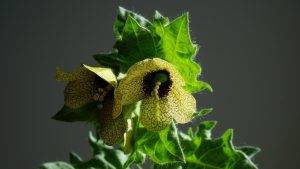
Hendane – Hyoscyamus niger
Description of Hendane:
Hyoscyamus niger (Old or other names: fool’s bane, fool’s bane, fool’s bane, bilin, bilind, bilim (in Transylvania), buffalo, fool’s bane, fool’s bane, pig’s bean, seducer’s bane) Its name is Old Greek ‘bolinda’, but some believe it comes from a word of Slavic origin. Solanaceae (potato family) A annual or biennial plant that reproduces from seed. In the first year, it usually produces large leaves with only a stalk, which form a dense – sometimes huge – rosette of leaves. After sprouting, it produces a tall stem which flowers, matures into seeds and dries out. Sometimes, however, it flowers in its first year, when it is an annual. Its roots, similar to parsley, are yellowish to brownish, white inside and grow straight down into the ground to about 10 cm, hardly branching. Its leaves are pale green or greyish green, elongated egg-shaped, with lobed lobes, the lower ones tomentose, the upper ones sessile, and stalkless. It can grow to a length of l m and is covered with glandular hairs which, when grasped, give a sticky sensation. The stem is hollow and slightly branched inside, with a few thicker lateral branches. The stalked leaves are 15-30 cm long, 8-15 cm wide at the centre, with deeply notched, roughly toothed edges. The leaves on the stem are one-third or half the size of the stem leaves. The leaves are pointed-tipped, thick and mostly hairy. Flowers are very short-tubed, almost tongue-less, single in the axils of the upper leaves and more densely packed at the top of the stem. The most conspicuous feature of the flower is the cup-shaped, greenish, very hairy, one-piece calyx with a five-toothed flange. The calyx remains after the flower has faded and even grows to enclose the pistil. The calyx around the mature pistil is so sharp-toothed that it stings. Inside the calyx is the pistil, which is funnel-shaped, also in one piece; its rim has five rims. The paste is a dirty yellow with dark purple veins and a dark purple ‘throat’. The outer side of the cushion is hairy, the inside is bald. Inside the pair there are 5 stamens, which are attached to the pair at the base. Inside the flower is the seed coat, from which the pistil is produced. The latter is surrounded by the remaining calyx. The lower part of the receptacle is longer and the upper part narrower, with two compartments; when mature, the lid at the top opens up, releasing the large number of seeds. The seed is slightly flattened, kidney-shaped, with a jagged surface, brownish grey in colour. The belendek flowers from May to August.
Occurrence:
The beléndek is found throughout the country in rubbish dumps, manure dumps, dry ditches, village streets, outlying plots and waste ground, roadsides, mostly around human settlements. It was found next to arable fields, pastures and waterfronts. In lean, dry, sunny/semi-shaded places, it is worth sowing the inbreds. It also grows on rubble and rocky soils. It also grows in fields irrigated with Berlin sewage (1906). It should be propagated from seed as it does not like transplanting. Its seeds should be sown very shallowly in late autumn or early spring. In spring it should be harvested and thinned out to 15 cm. In bare, rocky places, from Britain, south of central Norway, to Portugal and Greece throughout Europe. Also found in Siberia, the Caucasus, northern India and North America.
Beléndek influence:
Belindec is a very poisonous plant! The whole plant has an unpleasant, intoxicating odour. When ingested, it causesdizziness, headache, paralysis, stupor and eventually death. In case of poisoning, the poisoned person should be given an emetic and strong vinegar. All parts of the intestine contain a poisonous substance called hyoscyamine. Most of this is in the root, which is the most toxic, followed by the seeds. The seeds and leaves have antispasmodic and analgesic properties when ingested in small quantities, and the leaves and seeds are used in medicine under the names herba hyoscyami and semina hyoscyami. It has parasympathetic (part of the digestive and vegetative systems) nervous system inhibitory effects. The fresh leaves are used to make intestinal extract and intestinal oil(extractum et oleum hyoscyami), which are used for their sedative, analgesic, anti-inflammatory and sleep-inducing properties for a wide range of ailments, especially spasms, dysentery and nervous fever, but also as a rub for rheumatic pains. It has also been used against gout and has been an ingredient in (love) potions. In the past, it was used to make witch’s ointment (witch’s wax cremation ointment). Its dried root can be used to kill mice. It was also used to make intoxicating medicines. In the old days, a decoction of incense and poppy was often given to the patient to soothe the pain of the medical ‘procedure’. It was believed that ingestion of the plant would cause clairvoyance. In our country it was also used for toothache, dried and sprinkled on coals and the patient had to stand over the rising embers with his mouth open. Dioscorides notes that the seeds of belendek were mixed with poppies and opium in mead. The Germanic peoples also used it as a stimulant, the seeds were also mixed into beer, known as pilsen beer . The Beer Act of 1516 banned the use of inulin seeds, a law that can be called the first anti-drug decree. Side effects: Cardiac dysfunction, palpitations, increased pulse and blood pressure, rapid and deep breathing, pupil dilation (light sensitivity), loss of eye accommodation (blurred vision), dizziness, vomiting, nausea, loss of balance and movement, hallucinations, agitation (psychomotor agitation), chills, fever/high body temperature, convulsions. Intoxicated behaviour resembles that of a “mad” person, may cause brain dysfunction and impairment.
Active ingredient:
Hyoscyamine and scopolamine, atropine. Coumarin, flavonoids, tropane skeleton alkaloid, arsenic, iron, fat, zinc, copper, trimethylamine, protein, sodium, resin, calcium, magnesium, manganese, potassium, tannin, choline, coumarin, palmitic acid.
Cultivation of Beléndek:
A non-selective plant in soil, it grows best in nutrient-rich calcareous soil. It is grown by sowing seeds in March or June. It is advisable to freeze the seed, as frost shortens the dormancy period of the seed. The plant requires 30×40 cm of space. A catastrophic acre requires 2-3 kg of seed. The yield per acre is 5 to 6 q (bushels) of leaves and 4 to 5 q of seed. Ingestion: Belendek was one of the most sought-after native wild herbs, which (was) also worth propagating artificially. Its leaves should be harvested when belendek is in flower. The shoots of the beléndek are harvested from this end at or before flowering and the leaves are stripped off on their way home, then carefully sorted and stripped of stem parts, spread out thinly on a tarpaulin and dried in a shady place or in the attic. If the roots are also to be picked, the plants are uprooted and transported home cleaned, where the roots are then cut off and dried separately on tarpaulin. In this case, however, even more care must be taken to ensure that the leaves are clean and not earthy. The cleaner the leaves are picked and the better they are dried, preserving their green colour, the more valuable they are, 6 kg of fresh leaves will produce 1 kg of dry leaves. The seeds should be picked before they are fully ripe and half ripe, because if they are picked when they are fully ripe, most of them will sprout when cut. The cut, half-ripe stems with the capsules on them can be left for a few days to ripen fully or spread out in another sunny place and plucked when fully ripe. The plucked seeds are threshed and cleaned. If seeds are taken from the inbreds, leaves cannot be taken from the same shoots, as the latter must be taken earlier and the inbreds, which have been stripped of their leaves, cannot ripen. Since it takes a lot of small seeds to produce a kilo of belindec seeds, it is better to pick the leaves and leave only those that cannot be sold for harvesting Alfalfa:
- Hyoscyamus albus L.
- Hyoscyamus aureus L.
- Hyoscyamus aureus aureus L. Hyoscyamus aureus aureus L.
- Hyoscyamus muticus L. Hyoscyamus niger L.
- Hyoscyamus pusillus L.
- Hyoscyamus reticulatus L.
Occurrence Medicinal properties Active ingredient Collection Cultivation Source: Dr. Ferenc Darvas and Dr Gyula Magyary-Kossa,Domestic herbs, their production, marketing, effects and medicinal use Béla Páter, Wild medicinal plants Image by Jaanus Leoste from Pixabay

